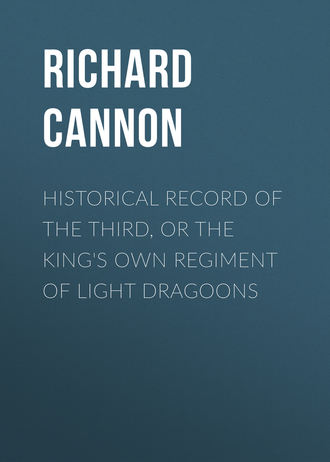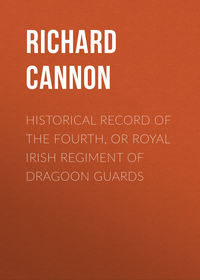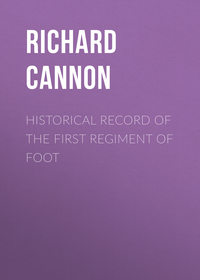 полная версия
полная версияHistorical Record of the Third, Or the King's Own Regiment of Light Dragoons
1800
1801
In February, 1800, the King's Own marched to Trowbridge, but only remained there a few weeks, and then proceeded to Chester to be reviewed. At this place an augmentation of two troops took place, making a total of ten; and on the 22nd of September, the whole regiment marched to Lancashire, thence to Carlisle, and, in December, to Scotland, the head-quarters being established at Hamilton; three troops, under the command of Major Wade, being detached to Carlisle and Penrith. At Hamilton, the regiment was reviewed by Major-Generals Erskine and Vyse, and the present system of casting horses annually first introduced; and as it was considered the peculiar privilege of the regiment to have black horses exclusively, those that had the slightest shade of brown, were sent to the fourth dragoon guards, none but black horses being retained, with the exception of one white for the kettle-drums.
1802
1803
1804
After the peace of Amiens in 1802, two troops were reduced; the number of men in the others being also reduced from 100 to 64; and, on the 11th of August, the King's Own embarked at Port-Patrick for Ireland, proceeded to Dundalk, and in the spring of 1803 marched to Belturbet. Here they were reviewed by Major-General Sir James Afleck, and were actively employed in patrolling the country during the excitement caused by the disturbances in Dublin, to which place they proceeded in March, 1804, and were quartered in the royal barracks.31
1805
1806
On the 5th of April, 1805, the first division, immediately followed by the others, embarked for Liverpool, and marched to Nottingham, where the regiment remained for two years; the second year's halt being at the express request of the magistrates of Nottingham and Louth. The war having been resumed, two additional troops were added to the establishment.
1807
The regiment marched to Chichester in May 1807, and being there reviewed by Major-General Hugonin, proceeded to Brighton, and was encamped on the hills above the present barracks, for the purpose of being reviewed, in conjunction with the first dragoon guards, by His Royal Highness the Duke of York. On the breaking up of the camp, the Third marched to Chichester, but were shortly ordered to Canterbury, where a brigade was formed, consisting of the second dragoon guards, and third and fourth dragoons.
1809
In January, 1809, the regiment received orders to embark at Portsmouth, for the purpose of joining the army in Spain, under Lieut. – General Sir John Moore, and had advanced some days' march, when it was recalled, on the arrival of the news of the retreat of the British troops to Corunna.
On the 20th of July, the regiment received orders to march to Ramsgate, and was immediately embarked for Holland under the command of Lieut. – Colonel Mundy, forming part of an expedition designed to effect the destruction of the French shipping and arsenal on the Scheldt. After remaining in the Downs for six days, the fleet sailed, and arrived off Walcheren on the 29th, remaining there upwards of a fortnight; and after the capture of Flushing, proceeded up the Scheldt as far as Fort-Batz. The enemy's shipping had, in the meantime, been removed higher up the river, and an immense force assembled to oppose the British armament; at the same time an epidemic disease broke out among the English soldiers. The fleet consequently retired down the river, and sailed for England; the King's Own disembarked at Ramsgate in September following, and proceeded to occupy Canterbury, as before the expedition.
1810
In April, 1810, in consequence of the riots in London, occasioned by the House of Commons having ordered Sir Francis Burdett to be lodged in custody in the Tower, the regiment was hastily ordered thither, marching all night, and arriving in Southwark at 7 A. M. The men were billeted on the south side of the Thames; an hotel near Westminster Bridge being the head quarters, and the Obelisk the alarm post. After the suppression of the riots, the regiment was ordered to Guildford, where it was reviewed by his Royal Highness the Duke of Cambridge, who was pleased to express his entire approbation of its appearance and discipline. On the release of Sir Francis Burdett from the Tower, the regiment was again sent to London, but remained there a few nights only, and then returned to Guildford.
1811
Napoleon Bonaparte, Emperor of France, having conquered Portugal, had placed his brother Joseph on the throne of Spain, supported by a French army. The efforts of the Spaniards and Portuguese to regain their liberty, which commenced in 1808, were continued to be aided by the British government, and a force, amounting at this time to nearly sixty thousand men, had been assembled in Portugal under the command of Lieutenant-General the Viscount Wellington.
In June, 1811, the King's Own Dragoons, having been reviewed on Wimbledon Common by His Royal Highness the Prince Regent, were, on their return to Guildford, completed to the field establishment by a draft of a hundred horses32 from the second dragoon guards, and ordered forthwith to proceed to the Peninsula. On the 25th and 27th of July the regiment embarked at Portsmouth, landed in the following month at Lisbon, under the command of Lieut. – Colonel Mundy, and having met with favourable weather during the voyage, the Lieutenant-Colonel commanding was enabled to cause particular attention to be paid to the horses in regard to cleanliness, exercise, &c. The mode adopted for this purpose was as follows: three or four horses were backed into the hold, where they were walked round for a quarter of an hour; their feet washed, and hand-rubbed; and they were shod, if necessary; by these means their state of health and efficiency, on their disembarkation at Lisbon, were such, that upon landing they were capable of undertaking immediate service.
The regiment was reviewed at Belem by Major-General Le Marchant, and mustered as follows: – 1 Lieutenant-Colonel, 1 Major, 6 Captains, 9 Lieutenants, 1 Cornet, 1 Surgeon, 1 Assistant Surgeon, 5 Troop Quarter-Masters, 1 Regimental Serjeant-Major, 1 Paymaster Serjeant, 1 Troop Serjeant-Major, 24 Serjeants, 24 Corporals, 6 Trumpeters, 6 Farriers, 480 Privates, and 518 Troop Horses.
The King's Own left Belem on the 19th of September, under the command of Major Clowes, (the Lieutenant Colonel having been compelled by sickness to remain at Lisbon,) and marching through Villa Franca and Santarem, arrived at Abrantes in Portuguese Estremadura on the 27th. Here they remained until the 15th October, and then advanced through Niza and Villa Velha to Castello Branco in the province of Beira, where they were reviewed on the 7th of December, by Lieutenant-General Sir Stapleton Cotton, who expressed his satisfaction at the very effective state of the men and horses.
1812
In consequence of the extreme difficulty of procuring forage, the centre squadron moved, on the 21st of December, to Idanha a Nova on the frontiers of Spain, and in these quarters the regiment remained till the beginning of 1812, when it was ordered to the front to form part of the army covering the siege of Ciudad Rodrigo, being quartered at Aldea de Ponte and Fundao, and experiencing great inconvenience from the scarcity of forage.
In February, Lord Wellington having resolved on the siege of Badajoz, the capital of Spanish Estremadura, the King's Own marched south with their brigade (the fifth dragoon guards, and fourth dragoons,) and arrived at Borba in the Alemtejo on the 5th of March. On the 16th, a pontoon bridge was thrown over the Guadiana, and Badajoz was invested; the day previous to which the brigade moved from Borba, and crossing the bridge, formed the advance guard of the covering army, which continued to advance till it arrived at the foot of an extensive chain of mountains called the Sierra Morena. On the 26th, the King's Own marched at sunset from Medina to Campo, and at midnight joined a force under Lieut. – General Sir Thomas Graham, destined to surprise three battalions of French infantry and two regiments of cavalry lying in Llerena. Owing to a mistake on the part of the Chasseurs Britanniques (who formed the advance of the infantry column), the projected surprise failed, and the French retired into the mountains during the night, and took post at Azuaga, a town nine miles to the south of Llerena. On the 29th of March, after a sharp affair, the French were driven from Azuaga, and the head quarters of the Brigade were established there. The authorities of this town gave a superb entertainment to Sir Stapleton Cotton.
On the night of the 31st of March, a man deserted, who, it is supposed, gave information of the situation and strength of the British outpost; and on the 1st of April, a strong French force was detached to cut off the piquets at La Granja. A patrol, commanded by Cornet Ratcliffe of the Third, having met with the enemy's advance guard, was driven in, and the two British squadrons were attacked by seven squadrons of French cavalry, supported by infantry. After a severe struggle, the enemy, perceiving their surprise had failed, retired, and the piquets resumed their station.33 In this affair the King's Own lost thirteen men and twelve horses.
On the 2nd of April, Marshal Soult's army having advanced from Seville, with a view to raise the siege of Badajoz, the covering army began to retire before the superior numbers of the French. This retreat was continued through Usagre, Villa Franca, and Almandralejo, upon Albuhera, where, being supported by the besieging force, the army went into position on the 9th, and preparations were made for a general action. Soult, however, having heard of the fall of Badajoz, commenced a retrograde movement towards the frontiers of Andalusia on the 10th; on which day Major General Le Marchant's brigade, (the fifth dragoon guards, Third and fourth dragoons) forming the advance of the British, proceeded to Los Santos, and again in the night to Bienvenida, with the view of gaining the flank of the cavalry of a French corps (General Drouet's) encamped between Usagre and Villa Garcia; but the enemy retreated. The Brigade, however, defiled under cover of some heights, and by a flank movement came up with the French on the 11th in front of Llerena, charging and driving them into that town with the loss of one hundred and fifty prisoners, including several officers.
Intelligence was received of the advance of Marshal Marmont, on the north of Portugal. This general, leaving Ciudad Rodrigo and Almeida, on his rear, had pushed on as far as Castello Branco, thus threatening to destroy the communications of the British, by cutting the bridge of boats at Villa Velha. It therefore became necessary to reinforce the few troops left on that frontier, and Major General Le Marchant's brigade was one of those ordered for this service. It marched through Elvas, Estremos, Crato, Niza, and Villa Velha to Castello Branco, and finally took up its quarters at Val-de-rosa; but Marmont having retired into Spain on the approach of the British, the brigade returned to the Alemtejo, and was, on the 12th of April, stationed at Cabeca de Vide, Crato, and Fronteira, the King's Own being at the former place. On the 29th they received a sudden order to join a brigade of light cavalry, for the purpose of covering Lieut. – General Hill in his attack upon the tête-de-pont and bridge of boats at Almaraz, which brilliant exploit having been effected, the regiment returned to Cabeca de Vide on the 27th of May.
On the 1st of June the whole army, with the exception of Lieut. – General Hill's corps, moved to the north. On the 11th, Major-General Le Marchant's brigade arrived at Ciudad Rodrigo, and on the 12th was reviewed by Lord Wellington. On the 13th, the brigade moved forward and continued to advance till the 16th, when it found the enemy posted near Salamanca, and a skirmish took place which lasted till night-fall. On the 17th, the brigade crossed the Tormes, and was quartered near the village of Cabrerizos, and on the advance of the French, on the 20th, the whole army went into position on the heights of St. Christoval, with its right on the Tormes, and its left near Villares de la Reyna. On this day the brigade, being in front, sustained a cannonade of about an hour, and the King's Own lost twenty horses: the regiment afterwards took post on the summit of the mountain.
On the night of the 23rd the French army retired, and was followed at daybreak by the first and seventh divisions, and Le Marchant's brigade of cavalry, which crossed the river by the fords of Santa Marta; when Marshal Marmont, after a short delay, returned to his former position, and manœuvred for some days on the Tormes, but after the reduction of the forts at Salamanca, which took place on the 27th, he crossed the Douro at Tordesillas, closely followed by Lord Wellington, who, however, did not cross the river, but took up a position between Pollos and La Seca; Major-General Le Marchant's brigade being stationed at Pollos and Naval del Rey to watch the ford.
Marshal Marmont being strengthened by a division from the Asturias, pushed a column across the river on the 16th of July, in consequence of which the troops in Pollos fell back upon Fuente la Pena. On the 18th, it was understood that the enemy's army had passed the Douro at Tordesillas, by which manœuvre the safety of two divisions, and a brigade of cavalry, on the Trebancos, was much endangered, and Major-General Le Marchant's, with two other brigades of cavalry, were quickly moved up to cover their retreat, which was effected with trifling loss. The brigade had entered its bivouac near Canizal, when an order was received for a squadron of the King's Own to proceed to the support of two guns, intended to be placed on the hill above Castrillos. This order was soon increased to the whole regiment, which, on its march, discovered that the enemy was advancing in force, and pressing Major-General Alten's brigade very closely. Major Clowes immediately solicited, and received permission to go to their support, and the regiment accordingly advanced, and though checked by the fire of some French infantry, assisted in driving back the enemy's cavalry; the French infantry continuing to advance were repulsed by Lieut. – General Cole's division, and pursued with great loss. In this affair the regiment sustained the following loss; one serjeant-major, six privates, and four horses killed; lieutenant Branfell, and two privates wounded.34
On the 19th, the Brigade retired to the table land above the villages of Vallesa and El Olmo, and on the 20th, the hostile armies manœuvred within cannon shot of each other, the French moving to their left, and the British to their right. On the 21st the British went into their old position on the heights of St. Christoval, and the French crossed the Tormes at the fords of Alba and Huerta, marching to their left. To oppose this manœuvre, the British crossed the river at Salamanca. In the course of this day's manœuvres, Major-General Le Marchant's brigade crossed the river at the ford of Santa Marta three times, and took up its bivouac on the south bank opposite the town. In the course of this night so dreadful a thunder-storm burst upon the British lines, that the horses broke loose; many were lost by running into the French lines, and the remainder could not be secured till daybreak. The King's Own had to send to the rear an officer and sixteen men, severely injured by the horses, which were all linked together, running over them.
The morning of the 22nd of July, found the hostile armies opposed to each other. The British line was formed with its left on the Tormes, and its right on the rocky hills called the Arapiles; Major-General Le Marchant's brigade, quitting its bivouac ground, formed line in the centre of the position, to check the advance of the enemy's cavalry. The French marshal manœuvred to gain the road to Ciudad Rodrigo; his dragoons, after some skirmishing, were compelled to retire, and the King's Own again took ground to their right, passing the village of Arapiles, and forming in support of the fourth and fifth divisions. Lord Wellington, taking advantage of an injudicious movement made by his opponent, ordered his divisions forward, and the battle commenced. The French, attacked while making a complicated evolution, were instantly broken. A favourable opportunity for a charge of the British heavy cavalry occurring, the fifth dragoon guards, King's Own, and fourth dragoons, advanced, and a most animated scene presented itself. The din of conflict was heard on every side; clouds of dust and rising columns of smoke darkened the air, and enveloped the British squadrons as they rushed to battle. In front, the glittering bayonets and waving plumes of the French infantry were dimly seen through the thickened atmosphere; against these formidable ranks, the English horsemen dashed with terrific violence, the weight and fury of their charge broke the opposing lines, and in an instant the French musketeers were overthrown and trampled down with a terrible clamour and disturbance. 'Bewildered and blinded, they cast away their arms and ran through the openings of the British squadrons, stooping and demanding quarter, while the dragoons, big men, and on big horses, rode onward, smiting with their long glittering swords in uncontrollable power, and the third division followed at speed, shouting as the French masses fell in succession before this dreadful charge.'
'Nor were these valiant swordsmen yet exhausted. Their own general, Le Marchant, and many officers had fallen, but Cotton and all his staff were at their head, and with ranks confused, and blended together in one mass, still galloping forward they sustained from a fresh column an irregular stream of fire which emptied a hundred saddles; yet with fine courage, and downright force, the survivors broke through this the third and strongest body of men that had encountered them, and Lord Edward Somerset, continuing his course at the head of one squadron, with a happy perseverance, captured five guns. The French left was entirely broken, more than two thousand prisoners were taken, the French light horsemen abandoned that part of the field, and Thomiere's division no longer existed as a military body. Anson's cavalry, which had passed quite over the hill, and had suffered little in the charge, was now joined by D'Urban's troopers, and took the place of Le Marchant's exhausted men; the heavy German dragoons followed in reserve, and with the third and fifth divisions and the guns formed one formidable line two miles in advance of where Pakenham first attacked, and that impetuous officer, with unmitigated strength, still pressed forward, spreading terror and disorder on the enemy's left35.'
In this attack Major-General Le Marchant received a ball through the body, which terminated the career of that brave and talented officer. Lieutenant Selby, of the King's Own, was likewise killed by a musket-shot through the left breast.36 The result of this day was the entire overthrow of the French, 7,000 prisoners, eleven guns and two eagles remaining in the hands of the victors. The King's Own earned, on this occasion, the royal permission to bear the word 'Salamanca,' on their guidons. They sustained the following loss: Killed, – Lieutenant Selby, one serjeant, nine privates, and two officers' horses, and 13 troop horses. Wounded, – one serjeant, eight privates, and fifteen horses.
After the action the French retreated upon Alba, where they crossed the Tormes, and thence through Arevalo, upon Valladolid, sustaining in their march a severe loss from the German cavalry, which, having been uninjured in the battle, was despatched in pursuit of, and overtook their rear-guard three leagues beyond Alba, defeating it, and taking nine hundred prisoners.
The British army advanced on the route of the French, and entered Valladolid on the 30th of July; on the following day Cuellar was occupied, and on the 6th of August, the army moved on Segovia, crossed the Guadarama mountains on the 10th, and entered Madrid on the 12th; the brigade, now commanded by Colonel Ponsonby, forming the personal escort of Lord Wellington.
After halting seven days at Madrid, the brigade moved to St. Ildefonso, where it was cantoned for a few days. Intelligence was received that the army of General Clausel, who had succeeded Marmont, was advancing on Valladolid, and the British in consequence assembled at Olivares and its vicinity. An immediate attack was intended; but the artillery of the fifth division not arriving in time, the enemy retired on the 7th of September, having destroyed the bridge at Valladolid. They continued retreating rapidly till the 17th, when the immediate vicinity of Burgos induced Clausel to make a stand, and Colonel Ponsonby's brigade was ordered to the front; but, before the army could be formed for attack, the enemy again retired to Breviesca, leaving a strong garrison in the castle of Burgos.
The castle was invested, and the covering army took up a position on the heights of Quintana Palla, the King's Own being at Villa Yerna.
On the 19th of October, the French General Souham, who now commanded in the place of Clausel, being greatly reinforced, resolved to attempt the relief of Burgos. About four P. M. the French attacked and carried the village of Quintanapalla, but were repulsed in every attempt to penetrate farther, and abandoned the village on the approach of a force destined to retake it, consisting of the left wing of infantry, and Ponsonby's brigade of cavalry.
It being ascertained that Marshal Soult and Joseph Bonaparte were moving on the Tagus, and that Sir Rowland Hill, menaced by such powerful forces, could not maintain his position on that river, at the same time his retreat would leave the army before Burgos, already in a critical situation, quite insulated, the Marquis of Wellington resolved to retire so far as was necessary to form a junction with Sir Rowland Hill; and at dusk on the 21st, the army withdrew with such celerity and silence that the French were not aware of the retreat till the British had reached Hormillas, and did not show in any force till the evening of the 22nd of October. On the next morning the retrograde movement was continued in two columns, Ponsonby's brigade covering the column from Hormillas, and being threatened during the day by an immense body of cavalry. Such was the steadiness of the troops, that the overwhelming, force of the French could make no impression and the column went into bivouac for the night on the hills above Cordovilla, with little or no loss.
An hour before daylight on the 24th, the column, covered by Ponsonby's brigade, filed over the bridge of Cordovilla, and in the course of the day, the army crossed the Carrion, the head-quarters being established at Duenas. Early on the morning of the 25th, two squadrons of the fifth dragoon guards and Third dragoons were sent to the bridges of Palencia, to cover the party employed in mining them for destruction, but the French, advancing in force, gained possession of the bridges in an unbroken state. At this place the King's Own lost a man and horse by a round shot, and the party returned in the evening to Duenas; the army having in the meantime destroyed the bridges at that place, and at Villa Muriel, and the enemy having been defeated in an attempt to cross by the fords.
1813
The army retired four leagues on the 26th of October, and crossed the Pisuerga at Cabezon, in which town, and its vicinity, it remained till the 29th, when it retired early, and crossed the Douro at Tudela and Puente del Douro, the bridges at which places were blown up, as were those at Toro and Zamora; but the French having possessed themselves of the bridge at Tordesillas, the British on the following morning took up a position in front of it. In this position they remained till the 6th of November, when, the enemy having repaired the bridge of Toro, it became necessary to retire to Torrecilla de la Orden, and thence, on the 7th and 8th, to Salamanca. On the 14th, the French crossed the Tormes, and the British recommenced their retreat on the following morning, and entered Ciudad Rodrigo on the 18th; they afterwards went into winter quarters on the frontiers of Portugal, the enemy not advancing beyond the Yeltes. On the 20th, Ponsonby's brigade was at Albergaria, where it halted eight days, after which the King's Own proceeded by the route of Guarda, Celerico, and Penhancos, to Saixho. Here the regiment was quartered until the 28th of December, then at Arganil till February 11th, 1813, and afterwards at Soure, near the mouth of the Mondego, until the 19th of April.





